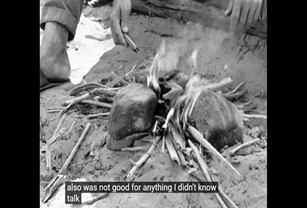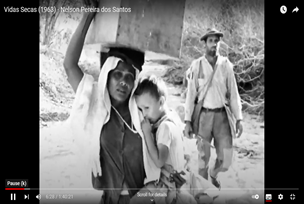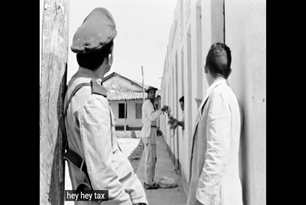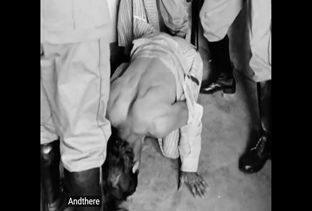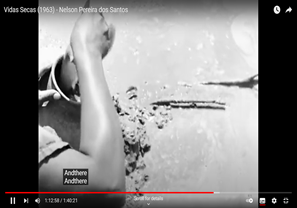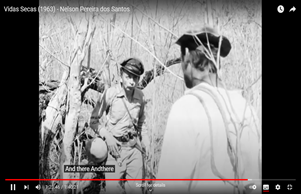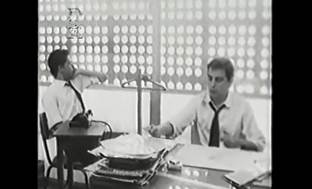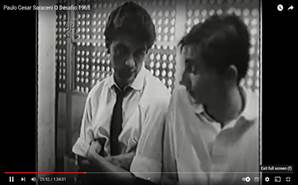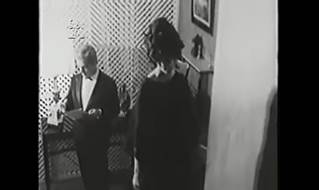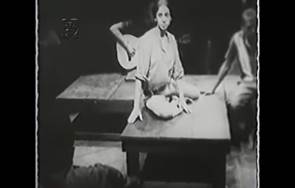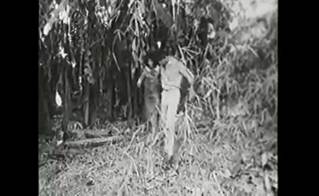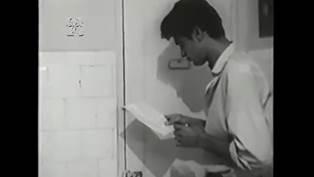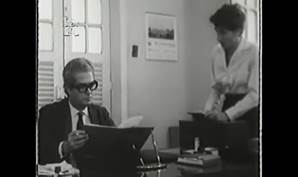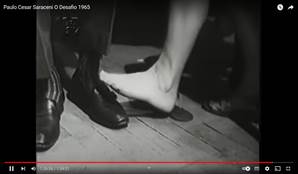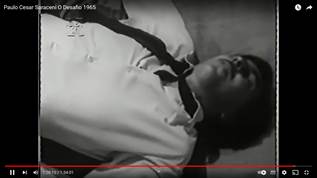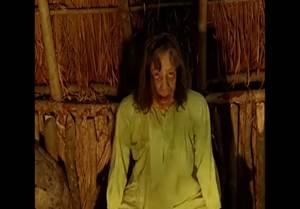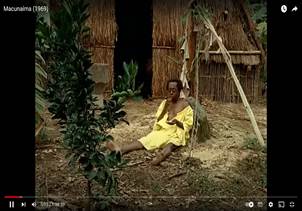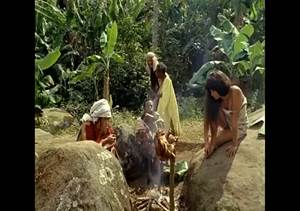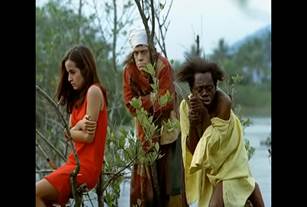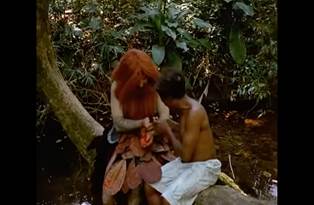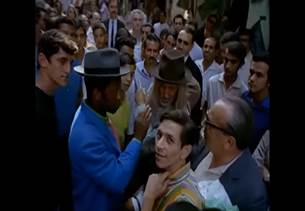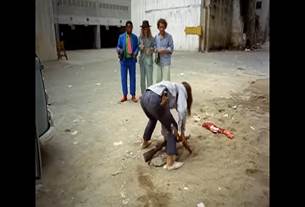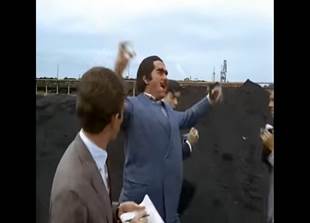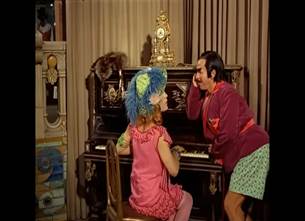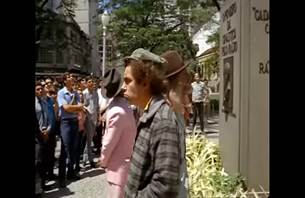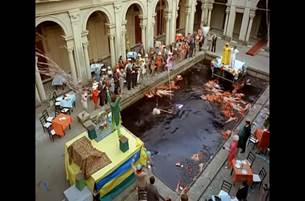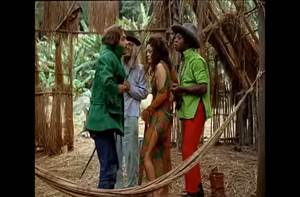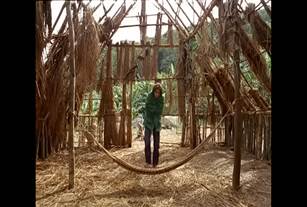ShodhKosh: Journal of Visual and Performing ArtsISSN (Online): 2582-7472
|
|
UNDERSTANDING THE PERSPECTIVES OF CINEMA NOVO: A CRITICAL DISCOURSE STUDY IN AGE OF RENAISSANCE IN LATIN AMERICAN CINEMA
Ruma Saha 1
![]()
![]() ,
Dr. Sharmila Kayal 2
,
Dr. Sharmila Kayal 2![]()
![]() , Dr. Lakhan Raghuvanshi 3
, Dr. Lakhan Raghuvanshi 3![]()
![]()
1 Doctoral
Research Scholar, Department of Journalism and Mass Communication, Manipal
University Jaipur, Rajasthan, India
2 Associate
Professor, Department of Media Studies, School of Media & Communication,
Adamas University, Kolkata, India
3 Assistant
Professor, Department of Journalism and Mass Communication, Manipal University
Jaipur, Rajasthan, India
|
|
ABSTRACT |
||
|
Cinema is the intrinsic creative expression which has often been reflected with many diversified perspectives. The auteur's perspective to the ‘masala movie, which always fascinates with its inclusive subject matter. It's been always interesting to ponder on how the narratives of cinema are swayed parallel with the conventional one. The filmmakers with their independent perspectives often been seen to focus or take the most untouched grey areas which generally deal with human’s life and endeavors (caste, class, creed, color, ethnicity, engendered social milieu, taboos, socio economic inequalities, grassroots problem, basic amenities, or simply different from the existence of human values with hegemonical counter-narratives been taken into account and reflected in cinema. The very idea of this present study is to understand the cinema culture of Latin American cinema (how it is different from New Wave Movement and Italian Neo Realism). The study focuses on the movement of cinema novo and selects a few notable movies to understand the ideation of narratives. The discourse analysis entails the reasons for the fall down of the movement and problem in order to decipher the meaning. The sole purpose of the study is to know treatment and approach of genre of cinema novo; to understand the metaphors and discourses; and to know the downfall of this movement in spite of always trying to mirror the unseen world to the rest of the world. This study suggests that this cinematic movement is a thorough reflection of the voiceless, poverty stricken and working-class condition of the people which should be taken up with a newer perspective and dimension. |
|||
|
Received 01 April 2023 Accepted 21 July 2023 Published 26 July 2023 Corresponding Author Ruma Saha,
ruma.saha.kolkata@gmail.com DOI 10.29121/shodhkosh.v4.i1SE.2023.410 Funding: This research
received no specific grant from any funding agency in the public, commercial,
or not-for-profit sectors. Copyright: © 2023 The
Author(s). This work is licensed under a Creative Commons
Attribution 4.0 International License. With the
license CC-BY, authors retain the copyright, allowing anyone to download,
reuse, re-print, modify, distribute, and/or copy their contribution. The work
must be properly attributed to its author.
|
|||
|
Keywords: Cinema Novo, Renaissance, Latin American Cinema,
Conventional, Narratives, Discourse |
|||
1. INTRODUCTION
Latin America comprises a group of countries in the southern part of America. Out of this group few countries are well known for their remarkable contribution to the field of art and culture especially film production. Countries like Mexico, Brazil, Cuba, Venezuela, Argentina, Peru, and Bolivia have a remarkable size in the film industry. Cinema production in Latin America can be traced back to 1896 when Lumiere Brothers projected their cinema in France Lenti (2007). Unlike Latin American literature, which is internationally applauded and has a global market, Latin American cinema is hardly seen outside the respective country of production. In recent times film critics and scholars are of opinion that Latin American cinema and the film industry are undergoing a renaissance Lenti (2007). Alejandro Gonzalez Inarritu is a Mexican filmmaker who earned Oscar and BAFTA awards and his movies like “Birdman” and “Revenant” created much interest in Hollywood for Latin American movies Matt. (2022).
2. LITERATURE REVIEW
The recent research essay was published by George Yudice on “Innovation and Development in Latin America” in
2018. The researcher studied trends in the cultural policy of Latin America;
firstly, economic contribution of creative and cultural industries, and secondly
cultural rights with importance given to access, inclusion, empowerment, and
well-being of the citizen. These two tendencies are not integrated properly
into cultural policies due to their logical, strategic, and management-wise
differentiation. Researchers in his study found the emergence of both
tendencies from the neo-liberation concept practiced during the 1990s which had
justified much cultural funding previously. The researcher tried to find an
innovative approach to compensate for limited funding. Different cases were
examined on cultural policies in Latin American forums over the past 20 years Yúdice (2018).
The
recent research on “The Empty Boat: Meteorango Kid
and Brazilian Cinema Marginal” by Dunn, published in 2020. Researchers examined
and considered “Meteorango Kid” (1969) as an
important contribution to Brazilian cinema in the context of the period of
1960s and 1970s. These films are called Brazilian cinema marginal which is
characterized by the low budget and finding aesthetics in the garbage,
conveying the message of the position of scarcity and marginality and misfit in
society. The researcher analyzed “Meteorango Kids” with
respect to cinema novo, cinema marginal, and Tropicalia in Bahian society amid
emerging youth counterculture Dunn (2020).
The
recent research essay published by Maite Conde in 2019 talks about the new
ideas of the film started flourishing in Europe in the 1920s where the film is
considered a piece of art. It has influenced Brazilian literature which gave
rise to the avant-garde literary movement called “modernismo”.
This further gave rise to new theories of film in Latin America. The researcher
tried to examine how this idea is appropriated and re-elaborated in Brazilian
literature. The case study was done on the works of Oswald de Andrade. Andrade
was a modernist who wrote about films during the early 20th century
in Brazil. Influenced by European technique Oswald de Andrade wrote about new
film theories, cinematic techniques, and re-conceptualizing realism in the
modern era. The researcher examines different works of Oswalde
and tried to find how his own cinematic experience has enabled him to challenge
traditional Brazilian writers while creating a new era of subjectivity in the
literature that is inherently cinematic Conde (2019).
A
research paper is published by Luis Trindade states about the comparative
analysis of documented motion picture of 1960s: La Hora de los
Hornos by Ferdinando Solanas
and Octavio Getino (1968, Argentina) and second one
is Le Fond L’Air est Rouge
by Chris Marker (1977, France). The researcher analyzed
the two films in the light of neo-colonialism and anti-imperialism which helps
in revisiting the period. The analysis helps us understand the film’s status in
the historical mediation of political struggle during the 1960s. These films
have challenged fundamental and traditional way of representing the struggles
of 1960s in film. The researcher in his essay concludes with overview of
historicity in film narratives Trindade (2022).
2.1. BRIEF ANTIQUITY
Early History of first motion picture
in Mexico and Argentina was screened in 1896. With the advent of Talkies both
Argentina and Mexican movies used commercial motion picture for regional area
and gradually, these films had a sizable market in the entire of Latin America.
Films were made in different genres like romance, crime, historical romance,
melodrama, political, historical romance, etc. Other Latin American countries
like Chile, Cuba, Venezuela, Columbia, Peru, etc also contributed to film
production Lenti (2007).
During the time of II war of Worlds,
few Latin American film industry suffered severely due to the U.S. policy of
supporting its allies and punishing its enemies. During this period Hollywood
was closed to Europe and so most Hollywood production targeted Latin American
audiences. Argentina’s film industry had to lose the market to the U.S. for
being neutral throughout the war period. Due to this reason, the industry was
almost dismantled. It took years for Argentina to get back to the pre-war
production figure and market value. Still, they could not regain her old
position with respect to the foreign market for their films. Mexico was highly
rewarded by the USA after the war for being an ally to the U.S. during the
period of war by supporting their propaganda through their films. The U.S.
rewarded Mexico after the war by constructing “Churubosco
Film Studios” Lenti (2007).
Era of New Latin America Cinema- In the
1950s era of Television in Latin America begins. People were addicted to this
new medium of entertainment which gives them a different variety of programs to
enjoy throughout the day. They didn’t feel the urge to go out to see movies in
the theatre. As a result, it impacted the box office heavily. The film industry
in Mexico tried to re-run their old, themed genre-based production to revive
the market. This did not create much
impact in the market and the plan failed. During the 1960s a new wave of film
production started which is based on real stories of political events of the
Cuban revolution and subsequent social unrest during that period. These films
were used mainly for communicating different concepts along with societal
changes related to them Lenti (2007).
From 1940 to 1965 in
order to boast cinema production many Latin American Administrations
built collaboration with prominent filmmakers for a developed comprehensible
and proper legislature. In Puerto Rico films were produced to solve
community-level problems and educate citizens. In Nicaragua and Cuba, films
were used as educational tools and mobile cinema units were sent to the
countryside to show movies and encourage community discussion on it Lenti (2007). Apart from this,
there was the growth of cine club/ film clubs at Latin American Universities
where movies were produced as well as screened regularly. These clubs had
remarkable contributions to the Latin American history of film.
In the 1980s Government of Peru passed
laws to encourage the promotion of Peruvian films through the mandatory
screening of all films, including short films in the domestic market. Laws were
enacted and Film Council was established to govern the promotion and
distribution of cinema. It boasted the Peruvian film industry and reconstructed
it. In Peru, a new milli filmmaker emerged who completed film production within
18 months, and this created a new wave of the journey in the Peruvian market Lenti (2007).
Restructuring- In 1978, the Ministry of
Communication in Columbia established Compaiiia
de Fomento Cinematogrifico,
a film institute for propagation of national cinema. FOCINE contributed to
production of 200 features in the format of shorts and documentaries and it had
generated considerable revenue in the domestic and international markets over
the years Lenti (2007).
In the 1990s, with the emergence of the
video cassette, the cable television Latin American film market had been
affected which resulted in shut down of many film theatres. Apart from this,
the Latin American film industry lose heavily to competitive Hollywood
production which offered an attractive distribution package. As a result, the
entire Latin American film industry was heavily affected Lenti (2007).
‘NLACF’ got established by all
representatives of Latin American Countries to develop celluloid cultural
identity and solve the distribution and exhibition problem faced by the
indigenous film industry of Latin America. The foundation worked for imparting
education in filmmaking was to break the U.S. monopoly. Through various
conferences and meeting all Latin American filmmakers came to the unanimous
decision to work with unity in production and distribution in Latin America. As
a measure of the objective, an integrated forum got established (Caracas,1989)
and recognised as Conferencia de Autoridades CinematogrAficas de Iberoamdrica, or CACI Lenti (2007).
Foundation wanted to bring legislation
throughout Latin America and unify the film market. CACI participants had
signed a Co-production Agreement, which helped in sharing of economic and
technical resources in film production that had doubled the market size.
Coproduction allows five countries to participate in the same project
simultaneously. Thereby strengthening the project’s market success rate for
countries with nascent film industries. Countries with established film
industries support nascent film industries of other countries and enhance unity
in upholding their integrity in capturing the Latin American market. During the
1990s almost all Latin American countries agreed to sign Coproduction Agreement
as it would give them a sizable market for the free flow of their films in
signatory countries Lenti (2007).
2.2. WHAT IS IT?
Unlike European cinema of the 1960s and
1970s did not have a specific foundation year of work. The name “New Latin
American Cinema” was given during the 1960s to a group of filmmakers belonging
to different countries in Latin America who shared a common interest since the
1950s focusing on societal problems in cinema Podalsky (2012).
Scholars have defined “New Latin
American Cinema” as political cinema meant to propagate revolutionary ideas
to transform society at large. During 1959 Cuban revolution deeply inspired the
political genre to become a popular medium to propagate ideology for
transforming society and social conditions. Films like “Memories of
underdevelopment” by Tomas Gutierrez Alea, “Entranced
Earth” by Glauber Rocha, and “Lucia” by Humberto Solas
dominated the decade of 1960s and the notion of revolution was at the core of
this new movement which created a renaissance in the Latin American Cinema Steele (n.d.). A group of
filmmakers during this time of unrest proposed and tried aesthetic
transformation of their “colonized culture”. Scholars have called this
transformation a cinematic “revolution” Podalsky (2012).
During the 1960s and 1970s entire Latin
America was torn by revolution and cinema was used to project it. Films
produced during this period emphasized the concept of revolution in the cinema
and created stereotypes of “political drama” Podalsky (2012). Scholars have
divided these filmmakers of the period into two groups. One group of filmmakers
wanted to use filmmaking as a medium to propagate revolutionary political ideas
for enhancing societal change. Another group of filmmakers concentrated on the
aesthetic revolution which is neutral of any political allegiance Podalsky (2012). Scholars have
argued that it is logical to draw a line of argument focusing on the
relationship between politics and art beyond modern terms of “polarization”
(which is used to define a relationship between neutral art and militant). Most
scholars have found the two notions as separate fields; only a few specific
filmmakers could find specific matching moments of both notions (art and politics).
Thus, the category of the genre “political cinema” is created in Latin American
films, to describe a cinema with the dominant content or topic of “politics” Podalsky (2012).
According to scholars, New Latin
American Cinema has included politics as an external element in the composition
of film content. Studies have revealed that Latin American filmmakers of that
period able to curate the uprising via film content as well as through formal
composition and logic of production Podalsky (2012).
Characteristics of New Latin American
Cinema: Studies showed that text written by film makers of that time revealed
an explicit position of cinematographic production and it’s the connection to
political attitude prevalent in that period Podalsky (2012). Moreover,
filmmakers of that period revealed positive nexus with revolutionary ideas.
Cinema was not only made for the cinematographic cause
but it was a medium of addressing a social problem. Whereas,
the French New Wave which also developed in the same period around the late
1950s pointed to film as a individual means of
articulation/expression/point of view. But Latin American filmmakers of the
period stated that cinema was an instrument of social change and therefore
never isolated from political trends of the times Podalsky (2012). Therefore, New
Latin American Cinema would reproduce “revolutionary ideas of the time” which
were working as an instrument to spread revolution Podalsky (2012).
European avant-garde cinema created the
idea of “autonomous cinema” which rejected external ideology and promoted the
independence of the author to uphold individual expression as according to
“Oberhausen Manifesto” a “new freedom”; Whereas, in Latin America, the
adjective “new” is related to creating resonance between cinema and other
political and cultural expressions. Scholars opined that the “novelty” of the
film lay in its political commitment instead of “its self-reflective character”
Podalsky (2012).
The cause of the beginning of “new
cinema” is different in Latin America when compared with Europe. Both Latin
American and European movements shared a common “enemy” of the period which was
Hollywood and its influence on the cinema production model of the nations. As a
result of the expansion of the market share of the commercial cinema of
Hollywood, it created a trend of reproduction of a “particular model of
narration” to revive the national film industry in many countries. Some
scholars have also opined that this model’s result was different according to
each movement. For Latin American filmmakers the problem was Hollywood film
production which had popularized instruments of colonization in Latin America Podalsky (2012). Therefore, it was justified that to revolt
against Hollywood is equal to revolt against colonization in a broad political
way. Scholars opined that problem was that the cinema represent a “symptom” of particular cultural and political conditions. This new and
changing cinema was part of societal transformation Podalsky (2012).
Scholars have opined because of
colonization of representation is that it creates an “alienated” view or
consciousness of reality. Karl Marx defined “alienation” as the distance
created between workers and their products by capitalism. Latin American people
could not get a true picture of their own social problems because they used
external concepts, categories, and information. Latin American filmmakers of
“new cinema” denounce the distance between people and reality. They rebelled
against this “colonialism” culture of alienation created by Hollywood.
Hollywood created a “colonized logic of representation” that distanced people
from understanding their own reality Podalsky (2012).
‘Revolution in content where cinema is
a means of knowledge’. Scholars have noted that New Latin American Filmmakers
had defined “reality” with respect to the cinema, where cinema is not simply
reproduction but a progression presentation which was only possible to be
visible through the “mediation of images”. This revolutionary characteristic of
the film is based on the deep trust in “naked reality.” Thus, the film story
revolves around real incidents and events of the time. Podalsky (2012)
Scholars argued about the contribution
of “Cinema Nova” to revolutionize the film content with the depiction of
“reality” in New Cinema in Brazil. Therefore, camera or cinematography not see with daily experience due to their “alienation” Podalsky (2012). Films like “Vedas Secas” (1963) are the best
example of it.
2.3. CHARACTERISTICS OF CINEMA
NOVO
The following characteristics of cinema
novo includes;
·
Profoundly predisposed by Italian Neo
Realism
·
Usage of unpopular actor
·
Low lensed/captive Cameras
·
Influence of other cinematic movement
(French/Auteur)
·
low budget and independent production
methods
2.4. THEORETICAL FRAMEWORK
Auteur Theory - The term auteur theory
is coined by Francois Truffaut based on the work of French critic Andre Brazin.
According to this theory, the director of a film is to be considered the
author. The critics have argued that the theory gives credit to the idea of the
director’s personal voice that comes through his work in any film. That means
even if the director is doing an adaptation film, he is using his artistic
skill to convey a certain message through his work Matt.
(2023). Critics have also
said that auteur theory is a way of film analysis where importance is given to
the role of the filmmaker or director in shaping every aspect of films from
storyline to cinematographic techniques. The theory influences the “French New
Wave” during the 1950s Matt.
(2023). It has created an
impact on Hollywood movies in later periods and has also impacted Latin
American movies.
Italian Neorealism – During World War
II the Italian directors were forced to search for an alternative way of
filmmaking when allied forces damaged the Cinecitta
film studio which was controlled by Mussolini (who used it to run his
propaganda). A group of Italian film critics highlighted on escapist nature of
Italian commercial films which evade real events of the period. All these
factors played a major role in bringing a sudden shift in Italian filmmaking
from cinematic style to a topic of discussion. This led to the rise of
neo-realism where due to lack of abundance; Italian filmmakers moved to streets
with minimal equipment and lots of real-world issues to focus. They used
non-popular stars to cast in their films which were produced at a minimal cost.
Stories of the working-class, real-world crisis were shown through movies after
Mussolini’s downfall What is Italian Neorealism? A Beginner's
Guide. Movements In Film. (n.d.).
Both auteur theory and Italian Neorealism have influenced the development of
the cinema novo movement in Brazil, which has revolutionized filmmaking in Latin
America and started a new style with more focus on real issues.
3. OBJECTIVES
The objective of the study includes:
·
to know the treatment of the genre of
cinema novo with its metaphors and discourses; and
·
to know the downfall of the movement of
cinema novo in spite of always trying to mirror the
unseen world to the rest of the world.
4. METHODOLOGY
The present study adopts critical
discourse analysis method to study the reasons for the fall
down of the movement and problem in order to decipher the meaning.
Critical Converse Analysis (CDA) is a
tool to dissect the verbal and social aspects. This composition aims at probing
the applicability of ideas amongst CDA pioneers— Van Dijk, Fairclough,
Kristeva, and Wodak - to both social and linguistic
studies. This paper includes some significant points similar
to narratives, representation, social practices, power as well as
intertextuality portrayed in selected films of cinema novo.
5. FINDINGS AND DISCUSSION
Cinema Novo:
Scholars argued about the contribution of “Cinema Novo”
(genre of cinema) to revolutionize the film content with depiction of “reality”
in New Cinema in Brazil. Therefore, camera or cinematography could depict that
“reality” which people could not see with daily experience due to their
“alienation” from mainstream society.
Films like “Vedas Secas” (1963) are the best example of it. Following (Table 1) are the cinemas
which profoundly contributed and best regard as the part of cinema novo.
Table 1
|
Table 1 First Phase of Cinema Novo |
||
|
Phase |
Name of the Film |
Year |
|
One (1960-64) |
Favela |
1962 |
|
One (1960-64) |
Porto das Caixas |
1962 |
|
One (1960-64) |
Barravento |
1962 |
|
One (1960-64) |
Os Cafajestes |
1962 |
|
One (1960-64) |
Ganga Zumba |
1963 |
|
One
(1960-64) |
Vidas
Secas |
1963 |
|
One (1960-64) |
Deus e o Diabo na
Terra do Sol |
64 |
|
One (1960-64) |
Os Fuzis |
64 |
The above-mentioned table depicts about the films that were
made during the first phase of cinema novo. There is total eight pioneered and
one of its kind novo cinemas were made during 1962 to 1964, among which the
most notable and exemplary work which gave cinema novo a universal acceptance
and world-wide acclamation. The critical discourses by portraying the
atrocities of a society well narrated and the plight of the authority very
well-articulated with counter narrative.
Table 2
|
Table 2 Stills from ‘Vedas Secas’ 1963 |
|
|
|
|
|
|
|
|
|
|
|
|
|
|
|
|
|
|
|
|
Source YouTube, 1963 film ‘Vedas Secas’ https://www.youtube.com/watch?v=CKsqPMikHVo |
|
The
first breakthrough cinema novo movie was Vidas Secas which was directed by
Nelson Pereira dos Santos in 1963. The movie breaks through the linear
mainstream approach and treatment which was adopted by the filmmakers earlier
to it. This movie is one of a kind and possesses a serious note to the backdrop
of economic crisis, unemployment, poverty, and atrocities of the authorities
(law and order).
This
is an eye opener which gives clues to the rest of the world and is able to create a separate language and mode of narrative
apart from new wave and neo realism cinemas. For example, still 1 and Still 2 analyzes the first glimpse of the establishment shot of vedas secas, the scene 3 and 4
emphasizes the scenario of dry land (no food, famine which made the people
nomad and migrate to earn their daily bread) which has tried to depict the
picture of various causes poverty and unemployment. Still 4 and 5 profoundly
narrates how the beloved pet also turning to meal. Still 6 and 7 are like
mirage of having a leather bed which was seem to be
impossible and there is a tax system of selling goods which have shown
beautifully with lawlessness, police atrocities and corruption of the
authorities.
Table 3
|
Table 3 Second Phase of Cinema Novo |
||
|
Phase |
Name
of the Film |
Year
1965-68 |
|
Two
(1964-68) |
Paulo
SA |
65 |
|
Two
(1964-68) |
A
Falecida |
65 |
|
Two
(1964-68) |
A
Grande Cidade |
66 |
|
Two (1964-68) |
O Desafio |
66 |
|
Two
(1964-68) |
O
Padre e a Moça |
66 |
|
Two
(1964-68) |
Menino
de Engenho |
66 |
|
Two
(1964-68) |
A
Hora e Vez de Augusto Matraga |
66 |
|
Two
(1964-68) |
Ipanema |
67 |
|
|
Terra
em Transe |
67 |
|
Two
(1964-68) |
Guerreiro |
68 |
|
Two
(1964-68) |
Fome de Amor |
68 |
Paulo
Cézar Saraceni's Challenge is a film made in the heat of time. As it can be
said “Better than an ultramodern film, a contemporary film”. Mugged in fourteen
days, the film traces a reflection about Brazil after the 1964 military
achievement, putting in the mouths of characters the veritably debate of the
recently defeated progressive camp.
Table 4
|
Table 4 Stills from the Film |
|
|
|
|
|
|
|
|
|
|
|
|
|
|
|
|
|
|
|
|
|
|
|
Source YouTube https://www.youtube.com/watch?v=hcggtO2bmvo |
|
O Desafio film is a corner within
Cinema Novo and is the first to address directly related to contemporary
political events in the country. A couple have their relationship shaken,
similar is the frustration of Marcelo (played by Oduvaldo
Vianna Filho), a youthful intellectual left wing who believed in the menace of
a process revolutionary in Brazil in the early 1960s. He’s paralyzed, feeling
helpless, with no prospects. Everything seems inoffensive conservative response
love, art, its product. The extremity sets in within the relationship, and Ada
(Isabella Cerqueira Campos) seeks to encourage him to move on with her, to fall
in love again, to move on with the effects he does, but Marcelo is withdrawn
and disabused. Ada is aged and married to a plant proprietor. She’s dressed and
lives in underprivileged conditions with a large house, employed, overlooking
the ocean, etc. witness the discrepancy between her hubby's archconservative
speech and the speech nut’s revolutionary, between his class condition and his
bourns intellectual and loving. Ada envisions Marcelo and his musketeers a
vitality in the face of the tedium of bourgeois life. In a discussion with the
hubby, says she needs “intelligent people, who live, people who have an idea,
who do commodity. One cannot stand so imperative futility at
the moment, these exchanges that lead nowhere, these empty people”.
Interestingly, unlike Glauber's film, O Desafio
got its new identity of being a connoisseur to scholars and dilettantes of the
history of cinema, maybe because of a lower gradational latterly line for the
director, maybe because his significance is generally linked to the moment in
which it was produced.
Table 5
|
Table 5 Third Phase of Cinema Novo |
||
|
Phase |
Name of the Film |
Year (1968-72) |
|
Three (1968-72) |
António das Mortes |
68 |
|
Three (1968-72) |
Macunaíma |
69 |
|
Three (1968-72) |
Os Herdeiros |
69 |
|
Three (1968-72) |
Azyllo Muito Louco |
69 |
|
Three (1968-72) |
Os Deus e os Mortos |
70 |
|
Three (1968-72) |
Como Era Gostoso
o Meu Frances |
71 |
|
Three (1968-72) |
Pindorama |
71 |
|
Three (1968-72) |
Os Inconfidentes |
72 |
These
includes most prominent movies been made in third phase.
Table 6
|
Table 6 Stills from the Film |
|
|
|
|
|
|
|
|
|
|
|
|
|
|
|
|
|
|
|
|
|
|
|
|
|
|
|
|
|
|
|
|
|
|
|
Source YouTube, 1969 film ‘Macunaíma’ https://www.youtube.com/watch?v=x7W4KSrWxaA |
|
Third phase of novo saw a popular mass appeal. These movies
were metaphorically deep and known best for their symbolic representation. Macunaíma is a depiction of comedy which based on mythical
character named ‘Macunaíma’. This mythical character
represents from racial deprived tribal community. Along with ‘Macunaíma’ who belongs to black community, an interesting
white character also are the main protagonists of this movie. The anatogonist tried to feast (‘Feijoada’- a Brazilian
cuisine) ‘Macunaíma’ for their local festival. The
characters lucidly depict the positioning, expressions in a very illustrative
way. The movie also narrates the then political scenario (republic of Brazin on
a toss) and set a tone for community distinctiveness which is quintessential
for revolutionized concept of the racism practice in Brazil.
6. OBSERVATIONS
The movement of cinema novo is a journey of entailing freedom
of expressions and thoughts. It was the time when Brazil was under military
rule (1964-85). Filmmakers used cinematic medium to raise their voice,
thoughts, expressions to the rest of the world in a poetic manner with deep
metaphor and symbolism. Dictatorship of military personnels were in rise in the
year 1965 and had curtails all civil liberties of living or maintain the social
order in hegemonical society. Dictatorship badly targeted and harmed
intellectuals, artists, academicians and turned badly ruining the economic
prosperity of the country and turmoil the political stand in world. It's
been always interesting to ponder on how the narratives of cinema novo were
swayed parallel with the conventional one. The filmmakers with their
independent perspectives often been seen to focus or take the most untouched
grey areas which generally deal with human’s life and endeavors
(caste, class, creed, color, ethnicity, engendered
social milieu, taboos, socio economic inequalities, grassroots problem, basic
amenities, or simply different from the existence of human values with
hegemonical counter-narratives been taken into account
and reflected in cinema novo. This cinematic movement able to receive appreciation
and critical recognition (positive) from rest of the world which made Brazilian
film movement (one of its kind movements) with innovative, illustrative way of
depiction many expressions. Basically,
Novo cinema not only portrayed the social but also the then scenario of
political and tried to focus the economic turmoil in order to
bring reform. On the other hand, it is proved that dominant/mainstream
narration is not only the ideal way of entertainment and hence it proved the
alternative paradigm of artistic expression can bring audiences positive
reaction and recognition in worldwide. It defeats the idea of conventional
style ideation of cinema. Cinema novo largely affected by the poetries and
music of Italian neo realism. Urban setting was most priority with a dominant
perspective influenced by socialists/communists. Basically, these cinemas
created to protest the military regimes atrocities, inequalities, urban slums,
racism, caste, and class struggle.
7. CONTRIBUTION OF ALEJANDRO
INNARITU AND HUMBERTO SOLAS
Alejandro
González Iñárritu’s films are a kind of cinematic poetry. They are not just
good, they are great. They are arguably
the stylish American filmmakers working moment. His films are so important because they're
so particular and so specific to their time and place. Amores perros (2000) Alfonso Cuarón’s Amores perros
(2000) is a masterwork that’s as emotionally important as it's technically
stunning. Cuarón’s first point film is an intimate, three-part masterpiece
about two couples on the run from the Mexican police a brace of lovers, and
their canine. The film follows the
relationship between man and beast over the course of several times, as both
are hunted by loose police officers while they struggle to survive on the
thoroughfares of Mexico City. Amores perros was shot in black and white with hand-held cameras,
performing in a unique style that recalls classic European cinema. It won
several awards including Stylish Foreign Language Film at the Academy Awards
and earned further than$ 60 million at U.S. theaters
alone (it entered a fresh$ 10 million when it was released overseas). In the
opening scene, Riggan Thomson, played by Michael Keaton, tries to get his hair
cut in front of a followership. He's more concerned with how he looks than with
the performance he's giving, which makes it hard for him to connect with his
character. Alejandro González Iñárritu’s
films are frequently described as “cinema of the senses.” The director’s hand
style is one that focuses on the most primitive rudiments of moviemaking sound,
image, and movement. His films are
frequently characterized by their raw emotionality, but they also tend to
feature a sense of humor in their characters’
dealings with each other. Alejandro
González Iñárritu’s point films are known for their dark, complex characters
and themes, but they also have a tendency to be
incredibly funny. The Mexican director has an inconceivable sense of humor and this is reflected in his
work in all stripes.
The
foremost prolific forerunner of the Cuban cinema which has achieved
transnational acclaim, because of Humberto Solas who
one of the directors who nurtured the Cuban cinema and brought changes through
revolution. The golden period in 20th century after the revolution.
Cuba was under military regime and freedom of artistic expressions were
compromised. Solas, the pioneered in Cuban cinema and
motivated others to made eighty cinemas and hence considered the golden era of
Cuban cinema. The diaspora of Cuban cinema also made possible because of Humberto
Solas.
8. CONTRIBUTION OF OTHER
PROMINENT DIRECTORS OF CINEMA NOVO
In
early phase of Brazilian Cinema was not successful among the audience because
of its lack of understanding/mass appeal. The movement of Brazilian legacy or
struggle was not properly disseminated then. In this regard the rise of film
makers and started this movement with an artistic rigor. Afterwards, the novo
presentation became popular and put on the practice and part of academic study
from 50’s to first phase of 70’s. After initiation of its experimental and
thorough portrayal of class struggle with human interest perspective, it was
successful in grabbing the universal attention through accolades as well as in
the form of constructive criticism from intellectuals.
9. WHAT AN ITALIAN NEO REALISM
INFLUENCE CINEMA NOVO FORMATION
The
liberation concepts been impoverished on various topics like migration, to
balance the new world order and to be at par with American lifestyle through
the Italian neo realism film makers. This led to think and motivate them to
portray these issues in Brazilian context and hence novo formation is possible
with the association of Christian theological ideology and with pragmatistic
notion. The cinema with only romantic genre which were not a prominent factor but
considered as only as ecstasy. “Como period gostoso
meu frans” is a classic example of cinema novo
and considered widely with its irresistible appeal through its narration and
able to get peoples acceptance. This movie later became an integral part of text books.
10. CONCLUSION
A vast amount of literature has been reposited on this
movement of new wave (cinema novo) since the 1970s. 1980s financial catastrophe
had a downbeat impact on the production of cinema. There is steady progress in
making alternate filmmaking which had marked the beginning of outstanding
filmmakers like New
Argentine Cinema which had the directors like Lucrecia and Caetano, along with
other prominent film makers. Filmmakers of Mexico like Iñárritu, Alfonso
also invigorated phenomenon of the country’s cinematic identity and able to get
recognition and acceptance in an international arena. Subsequently mid
90’s movie making in LA also invigorated drastically by transnational
co-creation in producing cinema possibilities which has aspired for propagating
in endorsing filmmaking in each country. Many contemporary studies highlighted
the new-fangled trend in Latin American cinema which showed a global
perspective and proved its enlightening culture worthwhile.
CONFLICT OF INTERESTS
None.
ACKNOWLEDGMENTS
None.
REFERENCES
Brazylyan Cinema. (2021, December 2). Barren Lives (Vidas Secas, Nelson Pereira Dos Santos, 1963) [English subtitles]. YouTube. Retrieved From 2022.
Conde, M. (2019). Brazilian Modernism and the Movies : Oswald De Andrade’S Cinematic Consumption. Romance Quarterly, 67(1), 8–21. https://doi.org/10.1080/08831157.2020.1698887.
Dina Sfat - Memorial. (2021, May 20). Macunaíma (1969). YouTube. Retrieved From 2023.
Dunn, C. (2020). The Empty Boat : Meteorango Kid and Brazilian Cinema Marginal. The Sixties, 13(2), 98–120. https://doi.org/10.1080/17541328.2020.1830478.
Hericodata. (2017, April 4). Paulo Cesar Saraceni O Desafio 1965. YouTube. Retrieved From 2023, January 1.
Lenti, P. (2007, September 25). The Latin American Film Industry Takes on Hollywood. NACLA. Retrieved From 2023, February 2.
Matt. (2022, September 30). 6 best Alejandro González Iñárritu Movies : Top Inarritu Films Filmmaking Lifestyle. Filmmaking Lifestyle. Retrieved From 2023, February 11.
Matt. (2023, January 24). Auteur Theory : The Definitive Guide Filmmaking Lifestyle. Filmmaking Lifestyle. Retrieved From 2023, February 12.
Podalsky, L. (2012). The Politics of Affect and Emotion in Contemporary Latin American Cinema : Argentina, Brazil, Cuba, and Mexico. Palgrave Macmillan US.
Steele, C. (n.d.). New Latin American Cinema Movement of 60S & 70s on DVD – Lista De Filmes. MUBI. Retrieved from 2023, February 11.
Trindade, L. (2022). A Ciné-Geography of Militant Cinema in the Age of Three Worlds. Making Global History Appear in the Long 1960s. Interventions, 1–19. https://doi.org/10.1080/1369801x.2022.2099943.
What is Italian Neorealism ? A Beginner's Guide. Movements In Film. (n.d.). Retrieved From 2023, February 13.
Yúdice, G. (2018). Innovations in Cultural Policy and Development in Latin America. International Journal of Cultural Policy, 24(5), 647–663. https://doi.org/10.1080/10286632.2018.1514034.
|
|
 This work is licensed under a: Creative Commons Attribution 4.0 International License
This work is licensed under a: Creative Commons Attribution 4.0 International License
© ShodhKosh 2023. All Rights Reserved.






